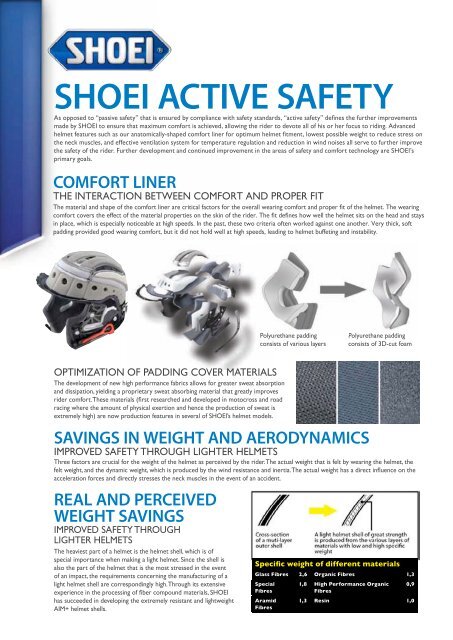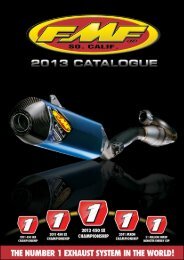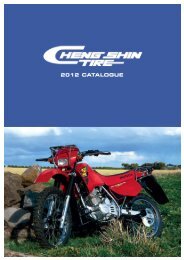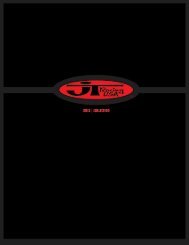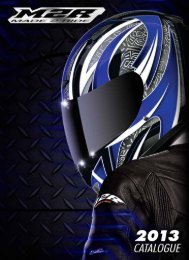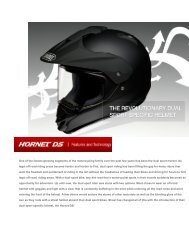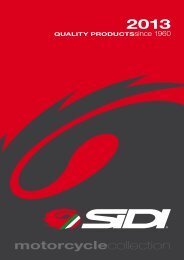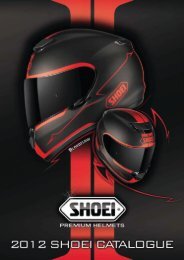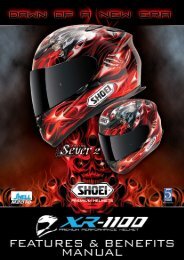Shoei Ibaraki Factory - McLeod Accessories
Shoei Ibaraki Factory - McLeod Accessories
Shoei Ibaraki Factory - McLeod Accessories
You also want an ePaper? Increase the reach of your titles
YUMPU automatically turns print PDFs into web optimized ePapers that Google loves.
SHOEI ACTIVE SAFETY<br />
As opposed to “passive safety” that is ensured by compliance with safety standards, “active safety” defines the further improvements<br />
made by SHOEI to ensure that maximum comfort is achieved, allowing the rider to devote all of his or her focus to riding. Advanced<br />
helmet features such as our anatomically-shaped comfort liner for optimum helmet fitment, lowest possible weight to reduce stress on<br />
the neck muscles, and effective ventilation system for temperature regulation and reduction in wind noises all serve to further improve<br />
the safety of the rider. Further development and continued improvement in the areas of safety and comfort technology are SHOEI’s<br />
primary goals.<br />
COMFORT LINER<br />
THE INTERACTION BETWEEN COMFORT AND PROPER FIT<br />
The material and shape of the comfort liner are critical factors for the overall wearing comfort and proper fit of the helmet. The wearing<br />
comfort covers the effect of the material properties on the skin of the rider. The fit defines how well the helmet sits on the head and stays<br />
in place, which is especially noticeable at high speeds. In the past, these two criteria often worked against one another. Very thick, soft<br />
padding provided good wearing comfort, but it did not hold well at high speeds, leading to helmet buffeting and instability.<br />
Polyurethane padding<br />
consists of various layers<br />
Polyurethane padding<br />
consists of 3D-cut foam<br />
OPTIMIZATION OF PADDING COVER MATERIALS<br />
The development of new high performance fabrics allows for greater sweat absorption<br />
and dissipation, yielding a proprietary sweat absorbing material that greatly improves<br />
rider comfort. These materials (first researched and developed in motocross and road<br />
racing where the amount of physical exertion and hence the production of sweat is<br />
extremely high) are now production features in several of SHOEI’s helmet models.<br />
SAVINGS IN WEIGHT AND AERODYNAMICS<br />
IMPROVED SAFETY THROUGH LIGHTER HELMETS<br />
Three factors are crucial for the weight of the helmet as perceived by the rider. The actual weight that is felt by wearing the helmet, the<br />
felt weight, and the dynamic weight, which is produced by the wind resistance and inertia. The actual weight has a direct influence on the<br />
acceleration forces and directly stresses the neck muscles in the event of an accident.<br />
REAL AND PERCEIVED<br />
WEIGHT SAVINGS<br />
IMPROVED SAFETY THROUGH<br />
LIGHTER HELMETS<br />
The heaviest part of a helmet is the helmet shell, which is of<br />
special importance when making a light helmet. Since the shell is<br />
also the part of the helmet that is the most stressed in the event<br />
of an impact, the requirements concerning the manufacturing of a<br />
light helmet shell are correspondingly high. Through its extensive<br />
experience in the processing of fiber compound materials, SHOEI<br />
has succeeded in developing the extremely resistant and lightweight<br />
AIM+ helmet shells.<br />
Specific weight of different materials<br />
Glass fibres 2,6 Organic fibres 1,3<br />
Special 1,8 High Performance Organic 0,9<br />
fibres<br />
fibres<br />
Aramid<br />
fibres<br />
1,3 Resin 1,0


